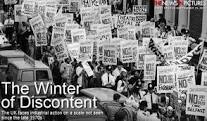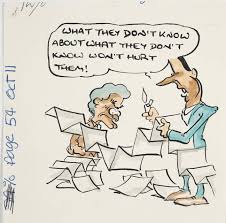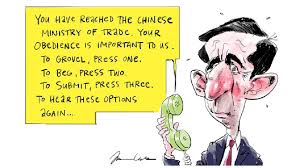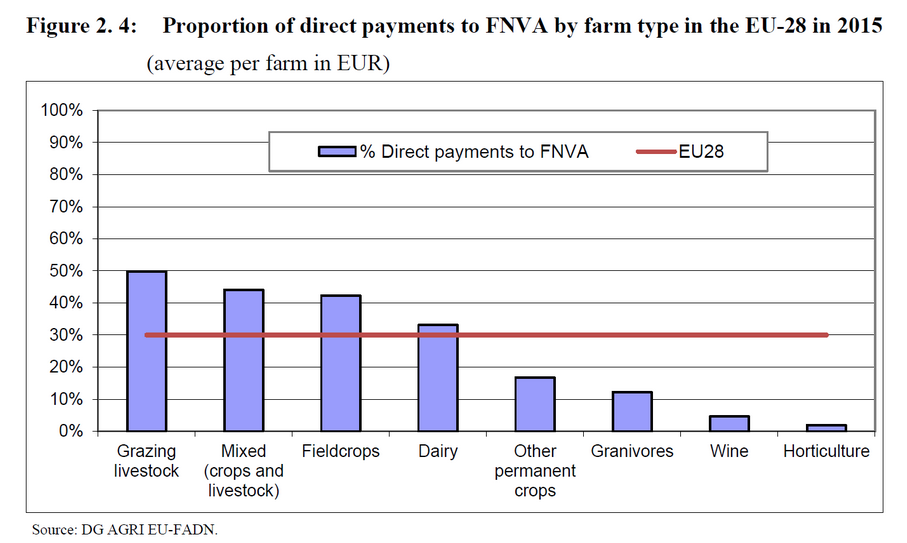Mr Albanese, the Leader of the Australian Labor Party, has a poor grasp of Australian political history.
Mr Albanese recently roundly criticised Treasurer Josh Frydenberg for channeling Margaret Thatcher and the policies employed by her to ensure the much needed economic recovery in the UK following Prime Minister James Callaghan and his self inflicted demise in his ‘winter of discontent’ of 1978/79.
Callaghan finally decided to call a General Election in 1979 after the country had been ravaged for years by high inflation and unemployment. In 1978/79 strikes in both the private and public sectors almost crippled the country.
 Uncollected rubbish was left to rot in the streets of London, the dead were not being buried, there was a mounting national shortage of food and fuel due to the truck driver’s refusing to work, which all combined to cause a crisis so bad the government considered declaring a state of emergency and mobilising the troops to take over vital services.
Uncollected rubbish was left to rot in the streets of London, the dead were not being buried, there was a mounting national shortage of food and fuel due to the truck driver’s refusing to work, which all combined to cause a crisis so bad the government considered declaring a state of emergency and mobilising the troops to take over vital services.
 Eventually, after strikes which were violent at times, the unions got the wage increases they wanted but it was a pyrrhic victory for them. The country, the people had had enough of the militant unions shambolically and carelessly wrecking the economy, so when they got the chance they elected Margaret Thatcher to be the first woman to be Prime Minister of the United Kingdom.
Eventually, after strikes which were violent at times, the unions got the wage increases they wanted but it was a pyrrhic victory for them. The country, the people had had enough of the militant unions shambolically and carelessly wrecking the economy, so when they got the chance they elected Margaret Thatcher to be the first woman to be Prime Minister of the United Kingdom.
In eleven years Margaret Thatcher rebuilt the UK economy and made it world competitive and respected if not liked around the world.
Albanese rejected what he saw as Frydenberg’s move to Thatcherism in favour his more Keynesian way of more and more government spending to build infrastructure and particularly social housing, for which, admittedly, there is a great need all over Australia.
Does Mr Albanese not know or does it suit his argument not to recognise that Bob Hawke and Paul Keating were the first Australian leaders to employ economic rationalism — they were the first true disciples of Margaret Thatcher?
They were Thatcherites through and through, they introduced Free Trade Agreements, globalisation and the ‘market economy’ to Australia.
It was under their government that we started to see the demise of the Australian manufacturing and food processing industry — all in the name of being ‘world competitive’.
It was also the start of a deliberate campaign to reduce the political power of agriculture in Australia.

Keating ‘s mantra was the ‘level playing field’, which meant open markets and the abolition of tariffs, the freeing up of the banking system and the selling off, the privatisation of government assets. With one of the highest basic wages in the world we opened our doors to competition from around the world. Keating also gave us the recession ‘we had to have’, 18% interest rates and he took us close to being a banana republic.
Hawke and Keating privatised assets which were owned by the people; Australian Airlines, Qantas, Aussat, OTC, Telecom and the Commonwealth Bank, all ostensibly to raise capital to restructure the Australian economy.
They also liberalised the foreign investment rules, floated the dollar and deregulated the crude oil market when Australia was self sufficient in oil. The Hawke Keating government and gained deserved reputation of being best conservative government since 1949.
The paradox at the time for some market Liberals was that Hawke and Keating were doing more to free up markets, deregulate the economy and introduce private enterprise principles into the public sector than had been achieved by three decades of coalition government.

Gough Whitlam and Malcolm Fraser.
The economy was a mess after the adventurism of Gough Whitlam, Lance Barnard and Jim Cairns, which peaked in 1974 as they tried to dupe Treasury and the Loans Council and organise a multi billion dollar loan through a Pakistani moneylender Tirath Kimlani. They met their Waterloo a short time later when Fraser denied them supply.

Hawke and Keating.

Forty years on from the Hawke and Keating years, years which have changed the industrial and manufacturing face of Australia, it is time to examine whether their philosophy of Free Trade Agreements (FTAs) free-markets and the abolition of tariffs have been good for Australia and particularly for Australian agriculture?
This is part of what I wrote a few months ago:
Fifty years ago in Australia we produced just about all the food we needed to feed 12.5 million people and we exported our surpluses. The food we imported was mainly to meet the demands of the ever-increasing diversity of the Australian population.
Over the last fifty years our population has doubled to 25.5 million.
Successive governments have told us that Free Trade Agreements are good for us and that globalisation is the epitome of the modern economy — and we haven’t argued well enough if we have disagreed.
Australia’s plethora of Free Trade Agreements with countries that have lower wages, cheaper power, lower taxes and fewer regulations or red tape than we have in Australia, has made it a lay-down-misere for importers of ‘cheap food’.
The big super-market chains, Coles, Woolworths and IGA are the de facto controllers of Australian agriculture. They have been given free and unfettered rein to scour the world for ‘cheap food’, and in so doing they have kept Australian governments and shoppers happy by keeping the cost of living down — and at the same time they have forced many Australian farmers and food processors out of business as they in turn have watched so-called cheap food flood the Australian market.
We gave the market away to others without a second thought.
Between 2001 and 2019 food imports into this country have grown from $8 billion to over $20 billion a year, an increase of 150%. (changed from previous report with new data.)A substantial proportion of those imports, of all things, are frozen vegetable packs. How silly is that? Australia grows the best and the cleanest vegetables in the world and we import vegetables from places like China.
 As the costs of running a food processing business in Australia made many uncompetitive, Australia’s loss has been New Zealand’s gain.
As the costs of running a food processing business in Australia made many uncompetitive, Australia’s loss has been New Zealand’s gain.
I had bacon and eggs for breakfast this morning, as I do most mornings. The eggs came from our local egg farm in Albany, the bacon was imported. Local bacon is available but it is expensive compared to imported bacon and local bacon is (usually) in hermetically sealed plastic packs and soaked in a gelatinous brine, usually cut very thin so what you eventually eat is far less than what you buy. On a budget one has to go for value every time. Australia imports pig meat worth nearly $1 billion a year.
My bottle of HP Sauce was made in the Netherlands and the salt in the grinder came from Pakistan. Why do we import salt when we have evaporation salt lakes in the north of WA? And the pepper came from South Africa, but it looks like they imported the peppers.
The bread I presume was made from Australian grain and we are always careful not to buy New Zealand butter. The marmalade was made in New Zealand — why is that when we grow oranges and lemons and limes in Australia?
‘Why are we importing food to the value of over $20 billion as year?’ when we could produce it all ourselves?
It is important to remember that the majority of the food Australia imports is processed food, food in cans, frozen, packeted and so on. We are self sufficient in fresh fruit and vegetables although we do import some out of season, and Australia is self-sufficient in all meat except for pig meat, we import 80% of what we consume and of course we are self sufficient in cereals, but that doesn’t stop us importing ‘confectionery’ to the value of over one billion dollars worth a year.
What Australia and Australian agriculture has lost over the last forty years is the ability, the industry, which can value add to the raw Australian agricultural product. Why do we import strawberry jam from New Zealand? (Cottees) Mashed potato from Holland? Peaches from Bulgaria? Biscuits from New Zealand ? (McVities) the list is endless and alarming.
Why does Australia import so much food?
As close as we can get to self sufficiency in food has to be an objective for this country as we re-build after this pandemic. Whether ‘we the people’ can persuade this and future governments to make this a national objective will depend of the advocacy of agriculture and those who represent agriculture in the parliaments of this country.
Don’t hold your breath on that score, because politicians of all political colours, including the agri politico types, don’t have a good record for being free thinkers. Policy is determined by the powerful and that is usually those from the city electorates and it is self-evident they don’t care where their food comes from.
We are where we are with food imports because over the last forty years or so nobody from the ‘bush’ has objected and nobody in parliament, especially those representing agriculture, has cared, has asked why?
In fact, there is a sound argument that for the last forty years or so our governments of all persuasions, state and federal have pursued FTAs at the expense of agriculture, farmers, and food processing in this country, not to mention the consumer who is not, as you will see, getting ‘cheap’ food.
Australia producers have watched while food processors have been driven out of this country by high costs. Why else would they move?
Then, to rub salt in the wound, those same processors use the produce of the country they have moved to, or produce they import from a third country like vegetables from China into New Zealand, to export the fruits of their labour back to Australia. There are so many examples of big companies moving out of Australia, Heinz and Mc Cain or Simplot, spring to mind.
The National Farmers Federation and their state affiliates seem to be more concerned about raising the output of agriculture to $100 billion at the farm gate by 2030 — but they haven’t said how, or achieving the fashionable — ‘on trend’ being friends to everyone by embracing the unrealistic ‘aspirational economy wide target of being carbon free by 2050’ (whatever that means) rather than concentrating on food import substitution at the same time as raising the profitability of Australian agriculture and making Australia truly self sufficient in food.
The economic theorists that prevail today both inside parliaments and the bureaucracy, the free traders. They consider import substitution something of a sin in a free trade agreement economy. That’s all very well for them polishing their leather chairs and protecting their six figure incomes, for agriculture the story is different — as a matter of policy our politicians and their bureaucracy refuse to recognise world trade reality — the blunt truth is this….
Agricultural Subsidies- US$560 billion a year.
Global agricultural subsidies amount to US$560 billion a year. That is US$1.5 billion a day. Globally we, the world, are wasting about 30% of the food we produce and the IMF calculates that world agriculture will have to lift the number of calories it produces globally by 70% if we are to feed the estimated population of 9.7 billion by 2050 and, how challenging is this, agriculture has to achieve that target AND (aspirationally) be carbon free into the bargain by 2050.
Seventy per cent of that increase in food production will have to come from the Developed World, Africa looks like having a food deficit for many years. Our grain yields in Australia are not improving. Sheep numbers are declining. Cattle numbers are rebuilding. Give Australian agriculture water and a leg up, then it will show the world.
It’s interesting that since 1990, 27 nations have switched from being net exporters of food to being net importers, including Honduras, the Philippines, Zimbabwe, and Vietnam.
The United States made payments or subsidies to American agriculture worth US$16 billion in 2019. President Trump’s position was and is that the American farmer is the best in the world and he will do everything within his power to support them financially as they face the head-winds of competition and the vagaries of China. Trump is also counting on his farmers for re-election.
Then there is this:
The one thing that Margaret Thatcher didn’t do and for that matter neither did Ronald Reagan, was to reduce agricultural subsidies. If I remember correctly they increased them.
The result was that the UK became a net exporter of food during the 1980s. That doesn’t mean that they stopped importing far from it, they were exporting food, but around 80% of the food they ate was home grown, today that figure, depending on who is quoting is somewhere between 50% and 60% and that puts the UK back in the precarious position it found itself in in 1939, and they are in that position in spite of receiving massive subsidies.
Whiskey is now the UKs biggest ‘food’ export product at £1.2 billion a year. (A$2.4 billion). Followed by salmon at £206 million and third is chocolate. Looking at those figures if Scotland gets independence the UK exports are going to take a thwack!
While in the EU it looks like farmers cannot survive without subsidies. Fifty per cent of the food we import is from America, the EU and New Zealand. New Zealand like Australia, hardly subsidises her agriculture, but she does have power prices and wage rates lower than in Australia. Power prices in America (about half ours) and in the EU except for Germany are all lower than those in Australia.
How can Australia compete with farmers in the EU?:

The full description of Fig2.3 is quite alarming, basically what this graph shows is the percentage of farm income, by country in the EU that is derived from direct payments. The average is 30%, the red line. In the UK it is 40% a little over for Ireland and topped by Slovakia and Finland at ~70%. Those are serious numbers especially when it is calculated, by the OECD, that Australian farmers subsidies amount to just 2% of gross farm receipts and these are in the form of helping mitigate variabilities in farm income due to season.
The subsidies listed here do not directly affect the price of goods/food in the market/shops, the price of wheat is the price of wheat the world over given a few dollars. Subsidies are paid to the producer and they go straight into meeting the costs of production. An example would be buying machinery.
The cost of the next generation of John Deere harvesters is predicted to cost £850,000, so double that for Australian dollars, A$1.7 million is, I think, way out of reach for the majority of Australian growers who have to pay for their costs out of income generated from production, not so for those who receive subsidies.
We know that Australia is no longer a low cost of wheat production nation and we know we have some of the lowest yields per hectare in the world, yet we have to pay the same prices for farm machinery that others pay. The disadvantage Australian farmers have is obvious and it is probably why Australian agriculture is so deeply in debt and productivity is falling.

If we are going to compete with other countries in the processed food markets of the world, if only to produce at a price which will keep them out of our markets and allow us to become self sufficient in food, then there are going to be severe headwinds and these must be recognised by the Australian government. This is not a level playing field Mr Littleproud and Senator Birmingham, look at this, how does the Australian farmer compete?:
‘The main conclusion of this post is that, despite the different methodologies and definitions of public support, the various measures are very consistent and there is a very high level of agreement between them. Based on the Eurostat indicator, public transfers currently (average 2014-2018) make up around 35% of agricultural factor income and 57% of farm family income.’ Prof A Matthews. Author.
Fifty percent of the food we import comes from America, the EU and New Zealand. New Zealand like Australia does not pay farm subsidies that influence trade. The figures are skewed towards NZ, because of their stated relationship with China and its frozen vegetables coming into Australia through the NZ back door and we do have an FTA with NZ, so we can always find her dairy products on our shelves. But that is not all, NZ sends us biscuits and other confectionery, after all she is a wheat producer. I cannot find where we export any food to NZ, so the trade is one way.
Cost of living in Australia-Same as America more expensive than the EU.
It would be easy to assume that with such a large and growing food import business that those who import the food into Australia would be finding the worlds bargains for Australian consumers —alas that is not the case.
In the international ranking on grocery prices Australia lies at 14th just above America at 15th. The countries in the EU from whom we get a lot of food, and who have more expensive groceries than Australia are Luxembourg, France and Norway. The UK is cheaper than Australia as is New Zealand and the rest of the EU.
Fifty percent of the food we import comes from countries that pay the same price or less for a basket of groceries than we do here in Australia.
Conclusion.
Australia is an island nation and so it is not only good common sense but strategically sensible to become more self sufficient and even totally self sufficient in food. There is absolutely no agronomic reason why this cannot be achieved —but there are many other reasons why, unless there is massive reform, it will remain a pipe-dream and the nation will remain vulnerable.
If tensions around the South China Sea escalate from warm to hot, Australian trade with the world both export and import will probably stop for the duration of the conflict. That means our food imports will be severely affected as will our fuel supplies.
If we are to become world competitive we must create cost and a taxation policies that makes us competitive with the rest of the world. That means we have to be serious about the cost of fuel, electricity and labour. We cannot be globally competitive when we have some of the most expensive power in the world and there are only four countries in the world that have a higher monthly income after tax than Australia.
We cannot lower wages, so productivity must increase. They say we are the clever nation, well now is the time to prove it.


